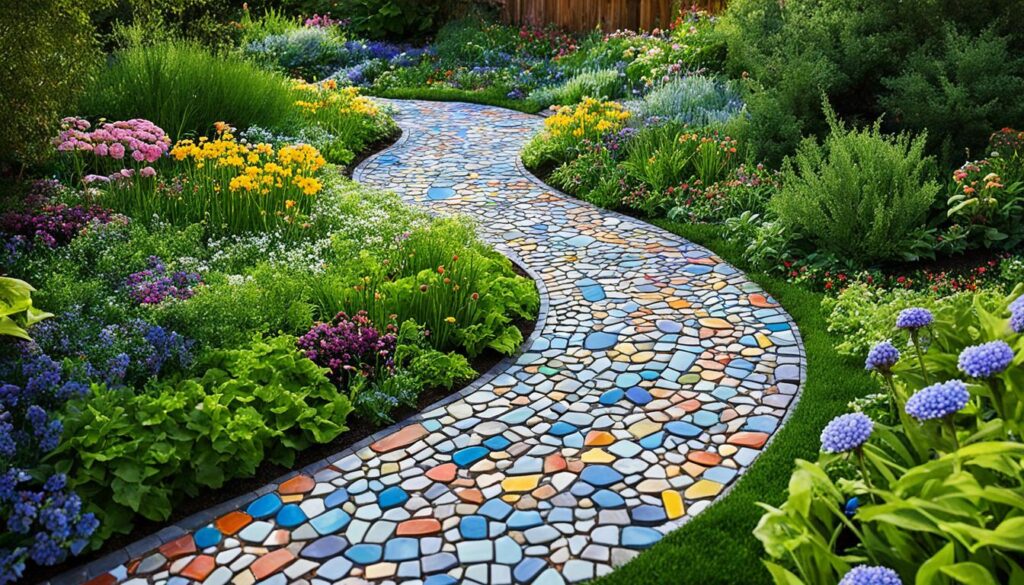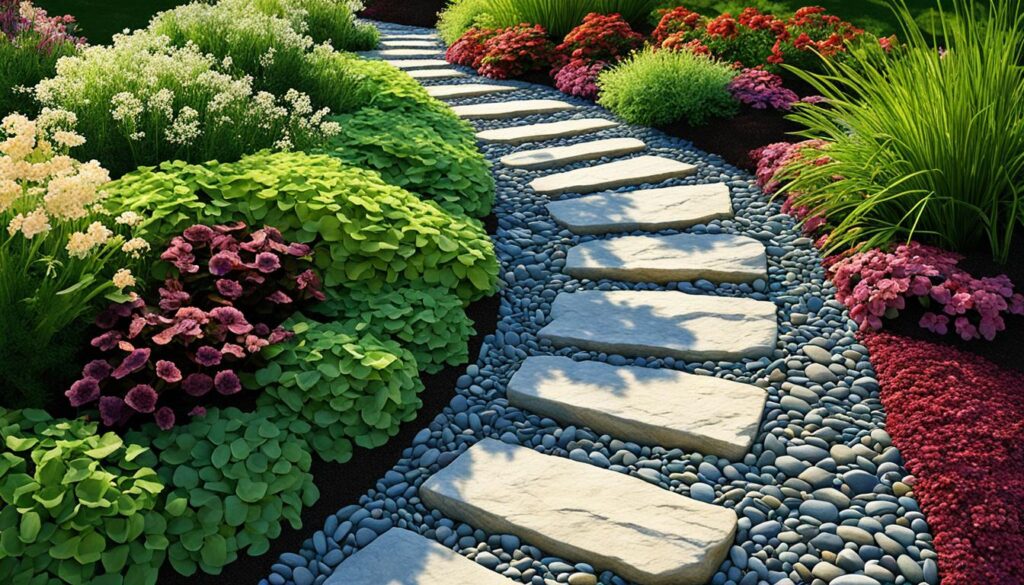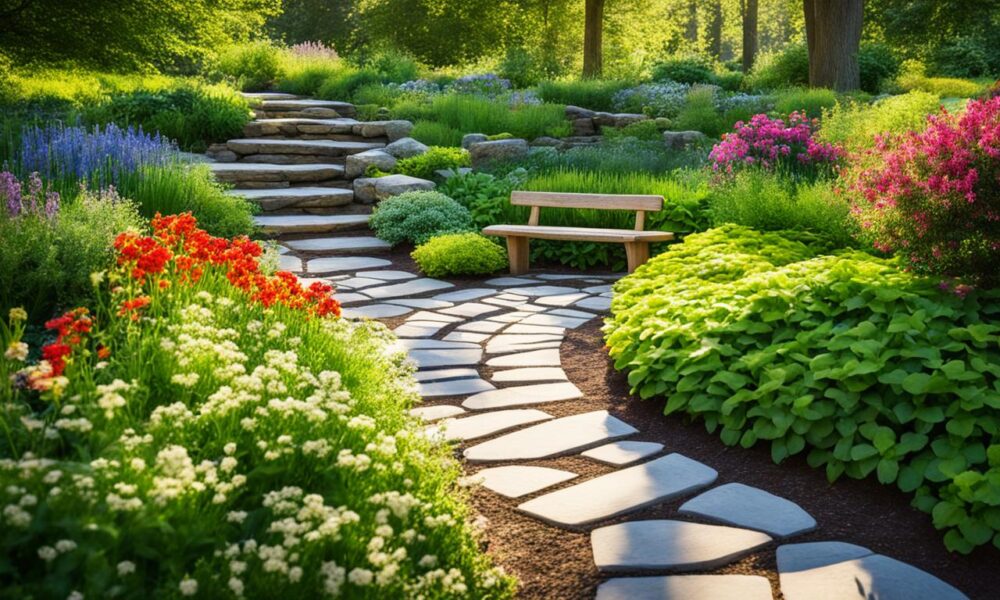Natural Stone Pathway Ideas for Garden Charm
DIY walkway ideas are a great way to add charm to your outdoor space. Installing a natural stone pathway can give your garden or yard a personal touch. With 50 unique walkway ideas for gardens, patios, and landscapes, you’ll find inspiration for every style and need. In this article, we will explore different types of natural stone pathways and how to install them.
Key Takeaways:
- DIY walkway ideas can add charm to your outdoor space
- Natural stone pathways offer a personal touch to your garden or yard
- Explore 50 unique walkway ideas for gardens, patios, and landscapes
- Learn about different types of natural stone pathways and installation techniques
- Find inspiration and ideas to create a beautiful and functional pathway in your garden
Choosing the Right Natural Stone for Your Pathway
When it comes to landscaping with natural stone, creating a beautiful stone pathway is a popular choice for many homeowners. The use of natural stone adds a touch of elegance and rustic charm to any garden or outdoor space. However, with so many options available, it can be overwhelming to choose the right type of stone for your pathway. In this section, we will explore various natural stone options and provide valuable installation tips to help you create the perfect stone pathway for your landscape.
Flagstone: Unique Texture and Earthy Tones
Flagstone is a popular choice for its unique texture and earthy tones. It is a flat, sedimentary rock that comes in various shapes, sizes, and colors, offering endless design possibilities. Flagstone is known for its natural irregularities and can be laid in a variety of patterns, such as a stepping stone style or a winding path. Its earthy tones blend seamlessly with the natural surroundings, making it an ideal choice for garden pathways and walkways.
Cobblestone: Charming Vintage Touch
If you’re looking to add a nostalgic and vintage touch to your pathway, cobblestone is an excellent option. Cobblestones are small, round stones that have been used in road and pathway construction for centuries. They offer a timeless appeal and can create a charming and rustic look in your garden. Cobblestones can be arranged in various patterns, such as herringbone or basketweave, to add visual interest and create a unique pathway that captures the essence of bygone eras.
Stepping Stones: Durability and Versatility
Stepping stones made of slate or bluestone are a durable and versatile choice for a natural stone pathway. Slate stepping stones offer a sleek and modern look with their smooth texture and rich colors, while bluestone stepping stones provide a more traditional and rustic feel with their natural cleft surface and shades of blue and gray. These stones can be arranged in a grid pattern or a meandering path, allowing you to create a unique design that complements your garden’s style and aesthetic.
Installation Tips for Stone Pathways
Installing a natural stone pathway involves careful planning and execution. To ensure a successful project, consider the following tips:
- Prepare the area: Clear the pathway area of any grass, weeds, or debris. Excavate the soil to a depth of at least 4-6 inches to create a solid base for the stones.
- Add a base layer: Lay a base layer of compacted gravel or sand to provide stability and prevent shifting of the stones over time.
- Select the right stone thickness: Choose stones with an appropriate thickness to withstand foot traffic without breaking or becoming uneven. Thicker stones are generally more suitable for pathways.
- Ensure proper spacing: Leave adequate spacing between the stones to allow for the growth of groundcover or grass, creating a more natural and integrated look.
- Secure the stones: Use mortar or a specialized adhesive to secure the stones in place, especially if they are irregularly shaped or prone to movement.
- Consider drainage: Ensure proper drainage by sloping the pathway slightly to prevent water pooling. This will help maintain the integrity of the pathway and prevent erosion.
- Maintain and seal: Regularly maintain the pathway by removing debris, weeds, and moss. To prolong the life of the stones and enhance their color, consider sealing them with a stone sealer.
By following these installation tips, you can create a beautiful and long-lasting natural stone pathway that adds charm and character to your outdoor space.
Creating a Rustic Flagstone Pathway
Flagstone pathways are an excellent way to add a charming and rustic touch to your garden. With their natural beauty and versatility, flagstones can transform your outdoor space into a picturesque haven. Whether you prefer irregularly shaped flagstones for a more natural aesthetic or uniform pieces for a sleek look, there are endless possibilities for designing a flagstone pathway that suits your style and preferences.
When creating a rustic flagstone pathway, consider arranging the flagstones in a stepping stone style or a winding path. This not only adds visual interest but also creates a sense of exploration as you navigate through your garden. Leave spaces between the flagstones for planting groundcover or small flowers, bringing a vibrant burst of color and blending the hardscape and softscape elements seamlessly.
The combination of texture and color in a flagstone pathway adds depth and character to your outdoor space, enhancing the overall ambiance of your garden. Whether you’re going for a rustic cottage feel, a Mediterranean-inspired oasis, or a serene zen garden, a flagstone pathway can effortlessly tie your landscaping design together.
Adding Vintage Charm with Cobblestone Paths
When it comes to creating a timeless and nostalgic atmosphere in your garden, cobblestone pathways are a classic choice. The rounded and worn appearance of cobblestones adds a charming vintage touch to any outdoor space, creating a pathway that exudes character and history.
One of the great advantages of using cobblestones is the ability to arrange them in various patterns, allowing you to express your creativity and create visual interest in your garden. Consider patterns like herringbone, basketweave, or running bond to add a unique and eye-catching element to your pathway design.
To enhance the natural beauty of cobblestone pathways and create a sense of timelessness, consider incorporating moss or creeping thyme between the stones. This not only adds a touch of greenery but also softens the pathway and creates a harmonious blend between the natural and man-made elements of your garden.
Benefits of Cobblestone Pathways:
- Adds vintage charm and character to your garden
- Creates visual interest with various pattern options
- Blends well with lush greenery, enhancing the natural beauty
- Provides a sense of timelessness and history
Whether you have a vintage-inspired garden or simply want to add a touch of nostalgia to your outdoor space, cobblestone pathways are a fantastic choice. Embrace the charm and uniqueness of cobblestones, and enjoy a pathway design that stands the test of time.
Exploring the Enchanting World of Stepping Stone Trails
Stepping stones provide an enchanting way to traverse your garden while enjoying the surrounding flora. Natural stone stepping stones, such as slate or bluestone, offer durability and a wide range of colors and textures. Create a meandering path using large, irregularly shaped stepping stones to add a sense of exploration and discovery. Enhance the visual appeal by planting low-growing groundcovers or creating small garden beds alongside the stepping stones.
Stepping stone pathways offer a unique opportunity to blend hardscape and softscape elements seamlessly. The irregular shapes and sizes of the stones create a natural look that complements any garden design. Whether you have a small urban garden or a sprawling landscape, stepping stones can be tailored to fit your space perfectly.
The combination of contrasting colors and textures between the stepping stones and the surrounding greenery creates a visually stunning effect. As you walk along the pathway, you can revel in the beauty of your garden while experiencing a sense of discovery and connection with nature.
Benefits of Stepping Stone Pathways
Stepping stone pathways offer several benefits for your garden:
- Versatility: Stepping stones can be laid out in various patterns and arrangements, allowing you to create a pathway that suits your personal style.
- Durability: Natural stone stepping stones are built to withstand outdoor conditions, making them a long-lasting choice for your garden.
- Low maintenance: Once installed, stepping stone pathways require minimal maintenance. Simply sweep away debris and occasionally hose down the stones to keep them clean.
- Accessibility: Stepping stone pathways provide a stable and safe surface for walking, ensuring easy access to different areas of your garden.
Aesthetic Considerations
When designing a stepping stone pathway, consider the following aesthetic factors:
- Stone Color: Choose natural stones that complement the overall color scheme of your garden. Earth tones like slate and bluestone blend well with lush green surroundings, while lighter stones can add a touch of brightness.
- Pathway Shape: Experiment with different shapes and sizes of stepping stones to create a unique and eye-catching pathway. Mix irregular and uniform stones for added visual interest.
- Planting Options: Enhance the beauty of the stepping stone pathway by planting low-growing groundcovers or small flowers in between the stones. This adds a pop of color and softens the hard surfaces.
By carefully selecting the right stones, planning the layout, and incorporating the surrounding flora, you can create a stepping stone pathway that becomes a focal point of your garden.
Walking on stepping stones, surrounded by vibrant greenery, evokes a sense of serenity and harmony with nature. It’s like embarking on a magical journey every time you wander through your garden.
To inspire your garden path design, take a look at the following table showcasing different types of stepping stones and their unique characteristics:
| Stepping Stone Type | Material | Color | Texture |
|---|---|---|---|
| Irregular Slate Stepping Stones | Slate | Dark gray, blue-gray, green | Natural cleft or honed surface |
| Bluestone Stepping Stones | Bluestone | Blue-gray | Smooth or thermal surface |
| Flagstone Stepping Stones | Flagstone | Varies (gray, brown, tan) | Natural cleft or honed surface |
| Natural River Rock Stepping Stones | River rocks | Multicolor | Smooth surface |
Table: Different types of stepping stones and their characteristics.
With the wide array of options available, you can find the perfect stepping stones to create your dream garden path design. Let your imagination run wild, and embark on a journey of garden enchantment!
Minimalist and Contemporary Gravel and Stone Dust Pathways
For a contemporary and minimalist garden aesthetic, consider using gravel or stone dust as the base material for your pathway. The crunching sound underfoot and the visual texture of the small stones create a serene and tranquil atmosphere. Border the pathway with natural stone edging to define the path and prevent gravel migration. This type of pathway complements modern and Japanese-inspired gardens, providing a sleek and clean look that highlights the surrounding greenery.
Benefits of Gravel Pathways:
- Minimalist design aesthetic
- Low maintenance
- Excellent drainage
- Durable and long-lasting
- Allows flexibility in pathway design and shape
Benefits of Stone Dust Pathways:
- Smooth and compacted surface
- Eco-friendly and sustainable option
- Reduces weed growth
- Highly accessible and easy to install
- Cost-effective alternative to traditional paving materials
Whether you choose a gravel pathway or a stone dust pathway, these minimalist designs create a clean and contemporary look in your garden. The simplicity of these materials allows the surrounding greenery and landscape elements to take center stage, creating a harmonious balance between the built environment and nature.
“A well-designed gravel or stone dust pathway adds a sense of tranquility and elegance to any garden, creating a seamless blend between the natural and built environment.” – Landscaping expert, Jane Smith
Adding Artistic Flair with Mosaic Stone Pathways
Take your garden path to the next level by incorporating an artistic flair with mosaic stone pathways. This creative pathway design allows you to showcase your personal style and create a stunning focal point in your garden.
To create a mosaic stone pathway, start by selecting natural stones in different shapes, sizes, and colors. This variety will allow you to form intricate patterns or even depict pictures within your pathway. Whether you prefer a geometric pattern or a nature-inspired motif, the possibilities are endless.
Your mosaic stone pathway will become a conversation starter and a unique feature in your garden. Guests will be captivated by the intricate designs and the visual appeal it adds to your outdoor space.
Infuse your own personality into the design of your mosaic stone pathway. Let your creativity shine and let the natural beauty of the stones guide you. Whether you’re an abstract artist at heart or you prefer a more structured design, the mosaic stone pathway will reflect your individuality.
Ready to add an artistic touch to your garden? Get inspired by the mosaic stone pathway ideas below:
- Create a vibrant floral pattern using a mix of colorful stones
- Form an abstract design that flows and blends seamlessly into your garden
- Depict a favorite animal or a beloved nature scene within your pathway
- Choose stones with different textures to add depth and visual interest
- Combine various shades of the same color for a subtle and sophisticated look
With a mosaic stone pathway, you have the opportunity to transform your garden into a work of art. Immerse yourself in the creative process, and watch as your pathway becomes a masterpiece.
“A mosaic stone pathway is not just a path; it’s an expression of creativity and a focal point in your garden.” – Maya Wilson, Garden Designer

Get Inspired
Take a look at this stunning mosaic stone pathway design:
| Design | Materials | Colors |
|---|---|---|
| Geometric | Marble, Slate | White, Gray, Black |
Factors to Consider when Designing Your Backyard Pathway
Designing a backyard pathway requires careful consideration of various factors. By taking into account these important elements, you can create a cohesive and visually appealing pathway that enhances the overall design of your outdoor space.
1. Choose the Right Materials
One of the key decisions when designing your backyard pathway is selecting the right materials. Consider options such as brick, gravel, and flagstone, which offer different textures and aesthetics. Choose materials that suit your style and budget, while also complementing the surrounding landscape.
2. Assess the Outdoor Space
Before finalizing the pathway design, it’s crucial to assess the size and layout of your outdoor space. Take into account the dimensions and shape of the area where the pathway will be installed. Additionally, consider any existing landscape features like trees, flower gardens, or water features that may impact the pathway’s design and layout.
3. Consider the Style of Your Home’s Exterior
A well-designed backyard pathway should blend harmoniously with your home’s exterior style. Take cues from the architectural elements and color schemes of your house to ensure a cohesive look. Whether your home has a modern, traditional, or rustic aesthetic, the pathway should complement and enhance the overall design.
4. Reflect Your Personal Taste
Your backyard pathway is an opportunity to showcase your personal style and preferences. Consider incorporating design elements, colors, or patterns that align with your taste and personality. Whether you prefer a minimalistic approach or a bolder, more artistic design, let your pathway reflect your unique vision.
5. Utilize Landscaping Materials
Landscaping materials can significantly enhance the visual appeal of your backyard pathway. In addition to the primary pathway material, consider incorporating other elements such as natural stones, pebbles, or decorative border edging. These materials can add texture, depth, and contrast, further accentuating the pathway’s design.
“A well-designed pathway creates a sense of harmony and connection between different areas of your backyard, while also serving as a functional and visually pleasing element.”
By carefully considering these factors, you can create a backyard pathway that not only enhances the beauty of your outdoor space but also provides a functional and inviting pathway for you and your guests to enjoy.
Stylish and Functional Backyard Pathway Ideas
When it comes to transforming your backyard into a stunning outdoor oasis, the pathway design plays a crucial role. With an array of backyard pathway ideas, you can add both style and functionality to your outdoor space. Whether you prefer a modern geometric design or a more traditional look, there are endless options to choose from. Let’s explore some creative pathway designs that will enhance the beauty of your backyard.
1. Staggered Geometric Designs
Create a visually striking pathway by incorporating staggered geometric designs. This modern approach adds a unique touch to your backyard, combining straight lines and angles to create an eye-catching pattern. Use a combination of different materials, such as concrete pavers and natural stone, to achieve a stylish and contemporary look.
2. Square Stepping Stones
For a clean and minimalist aesthetic, consider using square stepping stones for your pathway. These simple yet elegant stones create a sleek and organized look, adding a touch of modernity to your backyard. You can arrange them in a linear or grid pattern, depending on your preference.
3. Flagstone Paths with Red Brick Borders
If you’re looking for a more traditional and rustic style, a flagstone pathway with red brick borders is an excellent choice. The natural beauty of flagstone combined with the warmth of red brick creates a charming and inviting atmosphere. This design seamlessly blends with a variety of landscape styles, from cottage gardens to farmhouse-inspired outdoor spaces.
4. Narrow Gravel Pathway
A narrow gravel pathway adds a touch of elegance and sophistication to your backyard. This design is perfect for creating a sense of exploration and discovery as you meander through your garden. The sound of gravel underfoot adds a soothing element to your outdoor experience, creating a tranquil atmosphere.
5. Stepping Stones with Grass Between Them
For a more natural and organic look, consider incorporating stepping stones with grass between them. This design allows you to maintain a lush and green landscape while providing a functional pathway. The combination of stone and grass creates a harmonious balance between hardscape and softscape elements.
6. Winding Brick Pathway
Add a touch of charm and whimsy to your backyard with a winding brick pathway. The curved design creates a sense of movement and intrigue, leading you through different areas of your outdoor space. The warm tones of brick evoke a cozy and inviting atmosphere, making it a perfect choice for traditional and cottage-style gardens.
7. Multiple Pathways for Different Areas
To maximize the functionality of your backyard, consider incorporating multiple pathways that lead to different areas. This approach allows you to create distinct zones for relaxation, entertaining, and gardening. You can combine different materials, designs, and widths to delineate each area and create a well-structured outdoor space.
With these stylish and functional backyard pathway ideas, you can transform your outdoor space into a stunning haven. Whether you prefer a modern, rustic, or traditional design, there is a pathway that will perfectly complement your backyard. Now it’s time to unleash your creativity and bring your dream pathway to life.
Combining Different Stones for an Eye-Catching Pathway
Add a touch of creativity and visual appeal to your backyard by combining different types of stones for an eye-catching pathway design. Mixing various stone varieties allows you to create a pathway that stands out and adds dimension to your outdoor space.
One idea is to mix straight gray flagstones with organically laid out gray pebbles. This combination creates a unique visual contrast and adds interest to the pathway design. The straight flagstones provide a structured element, while the organically laid pebbles offer a more natural and textured look.
Alternatively, you can create a pathway surrounded by a variety of stone types and sizes. For instance, you can use irregularly shaped flagstones, cobblestones, and stepping stones together. This diverse mix of stones adds character and charm to your pathway, transforming it into a focal point in your backyard.
By combining different stones, you can effectively zone each area of your outdoor space. Use larger stones or a different stone type to indicate specific areas, such as a seating area or a garden section. This zoning technique helps create a cohesive design while adding functionality to your backyard.
Let your creativity flow and use the stones to define the design elements of your backyard. Experiment with various combinations and layouts to find the one that best fits your style and vision.

Benefits of Combining Different Stones
Combining different stones in your pathway design offers several advantages:
- Visual interest: The mix of different stone types, colors, and sizes creates a visually dynamic and appealing pathway.
- Enhanced dimension: By incorporating various stones, you can add depth and dimension to your outdoor space.
- Flexibility: Combining different stones allows you to personalize your pathway design and adapt it to your specific backyard requirements.
- Unique aesthetic: Mixing stones provides a one-of-a-kind look that sets your pathway apart from standard designs.
- Unlimited creativity: There are no strict rules when it comes to combining stones, giving you the freedom to experiment and create a pathway that reflects your personal style.
Comparison of Different Stone Combinations
| Stone Combination | Characteristics | Best Suited For |
|---|---|---|
| Straight gray flagstones + organically laid gray pebbles | Contrasting textures and structured yet natural look | Gardens with a modern and natural aesthetic |
| Irregular flagstones + cobblestones + stepping stones | Eclectic and varied design with a charming vintage touch | Traditional or cottage-style gardens |
| Mixed varieties of stepping stones | Playful and whimsical look with a wide range of shapes and colors | Family-friendly gardens or spaces with a creative theme |
Creating a Free-Flowing Pathway in Your Garden
Designing a pathway that seamlessly blends with the organic nature of plant growth can enhance the beauty of your garden. By incorporating natural stones amidst grass and gravel, you can create a free-flowing pathway that mimics the unpredictable patterns found in nature.
Imagine strolling through your garden, surrounded by a mosaic of stones scattered in different directions. The varying sizes and shapes of the stones create an artistic effect, adding depth and texture to your outdoor space. As you walk, the stones give a gentle crunch under your feet, further connecting you to the natural environment.
Unlike traditional pathways with strict lines and symmetry, a free-flowing pathway brings a sense of informality and spontaneity to your garden design. It encourages exploration and discovery as you follow the meandering path, uncovering hidden corners and surprising vistas along the way.
Whether you have a sprawling garden or a compact courtyard, the organic pathway design can be tailored to suit your space. It brings a sense of harmony and tranquility, drawing inspiration from the beautiful chaos of nature.
Benefits of a Free-Flowing Pathway:
- Adds a natural and relaxed element to your garden design
- Blends seamlessly with the surrounding landscape
- Encourages a sense of exploration and discovery
- Creates a unique and visually appealing focal point
- Provides an opportunity to showcase diverse stone shapes, sizes, and colors
“A free-flowing pathway invites you to slow down, take in the beauty around you, and appreciate the small wonders of nature.”
To create a free-flowing pathway in your garden, start by marking the desired route with stakes or a garden hose. Remove the grass and dig out some soil along the path, ensuring a depth of around 2-3 inches. Fill the trench with a layer of gravel or crushed stone, creating a stable base for the stones.
Next, place the stones organically, allowing them to spread out in different directions. Mix and match stones of various shapes, sizes, and colors to create an interesting mosaic effect. Take your time arranging the stones, ensuring they are firmly set in the base material.
Once the stones are in place, fill the gaps between them with fine gravel or stone dust. This not only adds stability to the pathway but also creates an appealing contrast against the natural stones.
As a finishing touch, consider adding soft lighting along the pathway to create a magical atmosphere in the evening hours. Solar-powered garden lights or low-voltage landscape lighting can highlight the beauty of the stones while adding an element of safety.
Final Thoughts
Embracing the concept of a free-flowing pathway in your garden allows you to connect with nature on a deeper level. It provides a space where you can meander through your own personal oasis, immersing yourself in the beauty and tranquility of the natural world.
Conclusion
Natural stone pathways offer a wealth of inspiration to enhance the beauty of your outdoor space. Whether you opt for flagstone, cobblestone, stepping stones, or a gravel design, each choice provides a unique aesthetic and a profound connection to nature. By carefully planning the layout, incorporating lush greenery, and paying attention to every detail, you can create a mesmerizing garden path that transforms your outdoor oasis into a serene haven.
Let your creativity flow as you explore the diverse possibilities of natural stone, allowing its innate beauty to guide your path towards a breathtaking garden paradise. The organic textures and earthy tones of these pathways will not only add charm and appeal to your outdoor space but also create a seamless integration between your hardscape and landscape elements.
Be inspired by the myriad of natural stone pathway ideas available, and discover the perfect design that suits your style, budget, and personal taste. From rustic flagstone paths to enchanting stepping stone trails, each pathway design creates its own unique ambiance and becomes a captivating feature of your garden. So go ahead, embark on your journey to create a beautiful stone pathway that not only reflects your individuality but also invites a sense of tranquility and wonder.



